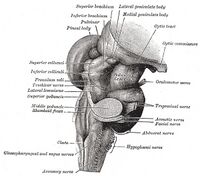
FAIR is a non-profit organization dedicated to providing well-documented answers to criticisms of the doctrine, practice, and history of The Church of Jesus Christ of Latter-day Saints.


In Ether 15꞉30-31, a final showdown occurs between two warriors, Shiz and Coriantumr. Coriantumr "smote off the head of Shiz...[and] after he had smitten off the head...Shiz raised up on his hands and fell; and after that he had struggled for breath, he died."
Critics insist that this would not, or could not, happen.

With the death scene of Shiz, Joseph Smith provides the reader with a vivid example of a catastrophic mid-brain injury which is consistent with a weary, sloppy cut made by the exhausted Coriantumr. Being a seasoned warrior, Moroni likely knew that such behavior would be relatively rare on the battlefield, even if he did not understand the rather precise neuroanatomy needed to cause it.
Shiz's death throes are a realistic touch, and represent a phenomenon that went unrecognized in the medical literature of the modern era until 1898. It is one more mark of the Book of Mormon's status as genuine history.
There are some statements in your Book of Mormon which no reasonable man can believe. At page 614, I read of a man who rejoiced in the name of Coriantumr, a man who would somewhat surprise our men of war in the present day; they lay siege to cities and garrisons; but ‘It came to pass that Coriantumr did lay siege to the wilderness.’ Still even this worthy is outdone by his antagonist Shiz; for ‘It came to pass that when they had all fallen by the sword, save it were Coriantumr and Shiz, behold Shiz had fainted with loss of blood. And it came to pass that when Coriantumr had leaned upon his sword, that he rested a little, he smote off the head of Shiz. And it came to pass that after he had smote off the head of Shiz, that Shiz raised upon his hands and fell; and after that he had struggled for breath, he died.’ Reader, this is in the Book of Mormon, and Latter-day Saints believe it to be the Word of God!”[1]
The Millennial Star of 1858 noted that lower animals were capable of movement after decapitation, and argued that the behavior of decapitated prisoners suggested that such an occurrence was not implausible.[2]
In 1900, the Millennial Star described a case in which similar behavior was observed:
It is claimed that the rising on the hands after decapitation is an impossibility.
The following from a dispatch to the Liverpool Daily Post of February 1, 1900, on the occasion of the seizure of Spion Kop, in Natal, should effectually silence all criticism on that passage:
‘There was an extraordinary incident in Wednesday’s battle. One of the Lancaster men, while in the act of firing in a prone position, had his head taken clean off by a large shell. To the astonishment of his comrades, the headless body quietly rose, stood upright for a few seconds, and then fell.’”[3]

Modern knowledge shows the Book of Mormon to be accurate on this point. Contrary to the critics' assumptions,
Shiz's death struggle illustrates the classic reflex posture that occurs in both humans and animals when the upper brain stem (midbrain/mesencephalon) is disconnected from the brain. The extensor muscles of the arms and legs contract, and this reflex action could cause Shiz to raise up on his hands.[4]
This makes the arms and legs rigid, which would raise a corpse up until lack of oxygen and blood loss caused eventual muscle failure.
People in this "decerebrate" reflex posture can also display "opisthotonos," a position "characterized by rigidity and severe arching of the back, with the head thrown backwards. This is such that if a person were laid on his or her back, only the back of the head and the heels would touch the supporting surface."[5] If the person — as in Shiz's case — were face down, the body would appear to rise up, with the neck bent backward and the face upraised. This dramatic positioning would make it appear as if the person was 'struggling for breath,' even though such behavior is a mere reflex, and not intentional.
Critical sources |
|

FAIR is a non-profit organization dedicated to providing well-documented answers to criticisms of the doctrine, practice, and history of The Church of Jesus Christ of Latter-day Saints.
We are a volunteer organization. We invite you to give back.
Donate Now